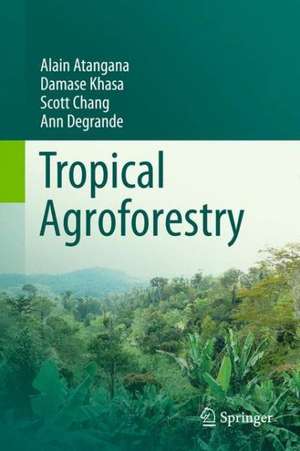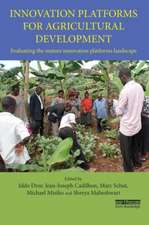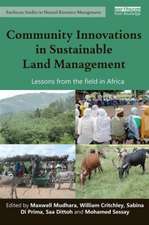Tropical Agroforestry
Autor Alain Atangana, Damase Khasa, Scott Chang, Ann Degrandeen Limba Engleză Hardback – 8 noi 2013
| Toate formatele și edițiile | Preț | Express |
|---|---|---|
| Paperback (1) | 1405.65 lei 6-8 săpt. | |
| SPRINGER NETHERLANDS – 4 oct 2016 | 1405.65 lei 6-8 săpt. | |
| Hardback (1) | 1472.12 lei 6-8 săpt. | |
| SPRINGER NETHERLANDS – 8 noi 2013 | 1472.12 lei 6-8 săpt. |
Preț: 1472.12 lei
Preț vechi: 1795.27 lei
-18% Nou
Puncte Express: 2208
Preț estimativ în valută:
281.94€ • 290.48$ • 236.18£
281.94€ • 290.48$ • 236.18£
Carte tipărită la comandă
Livrare economică 24 februarie-10 martie
Preluare comenzi: 021 569.72.76
Specificații
ISBN-13: 9789400777224
ISBN-10: 9400777221
Pagini: 350
Ilustrații: XXVI, 380 p. 107 illus., 27 illus. in color.
Dimensiuni: 155 x 235 x 25 mm
Greutate: 8.07 kg
Ediția:2014
Editura: SPRINGER NETHERLANDS
Colecția Springer
Locul publicării:Dordrecht, Netherlands
ISBN-10: 9400777221
Pagini: 350
Ilustrații: XXVI, 380 p. 107 illus., 27 illus. in color.
Dimensiuni: 155 x 235 x 25 mm
Greutate: 8.07 kg
Ediția:2014
Editura: SPRINGER NETHERLANDS
Colecția Springer
Locul publicării:Dordrecht, Netherlands
Public țintă
Upper undergraduateCuprins
Preface.- Acknowledgements.- Table of Contents.- List of Figures.- List of Tables.- Part I: Tropical Biomes, Land Use Issues and Introduction to Agroforestry Systems.- 1. Tropical biomes: classification and description.- 2. Major Land Use Issues in the Tropics, and the History of Agroforestry.- 3. Definitions and Classification of Agroforestry Systems.- 4. Major Agroforestry Systems of the Humid Tropics.- 5. Major Agroforestry Systems of the Semiarid Tropics.- 6. Participatory Domestication of New Crops using Agroforestry Techniques.- Part II: The Benefits and Services of Agroforestry Systems.- 7. Ecological Interaction and Productivity in Agroforestry Systems.- 8. Biological Nitrogen Fixation and Mycorrhizal Associations in Agroforestry.- 9. Agroforestry for Soil Conservation.- 10. Carbon Sequestration in Agroforestry Systems.- 11. Agroforestry and Biodiversity Conservation in Tropical Landscapes.- 12. Integrated Pest Management in Tropical Agroforestry.- 13. Diagnosis and Design (D & D) Approach and Participatory Rural Appraisal (PRA).- 14. Experimental Design in Agroforestry.- 15. On-Farm Agroforestry Research.- 16. Economics in Agroforestry.- 17. Socio-Cultural Aspects of Agroforestry and Adoption.- 18. Tropical Agroforestry for Biofuels Production.- 19. Phytoremediation in Tropical Agroforestry.- 20. Agroforestry and the Carbon Market in the Tropics.- 21. Agroforestry Modeling.
Recenzii
From the book reviews:
“Atangana (Univ. of Alberta, Canada), along with two colleagues from Canada and one from Cameroon, have done an excellent job of presenting the basic ideas and supporting them with examples from throughout the tropics. … the book is an important resource because of its clear presentation and broad coverage. Summing Up: Highly recommended. Upper-division undergraduates, graduate students, researchers/faculty, and professionals/practitioners.” (B. D. Orr, Choice, Vol. 51 (11), July, 2014)
“The 21 chapters of the 380-page book are organized into five major thematic sections (Parts I-V) related to tropical agroforestry. … present the current status of the subject matter in a concise, balanced, and non-controversial form and simple language that is understandable to both the teacher and the taught. … the book is an outstanding contribution to the development of agroforestry and the reviewer once again congratulate the authors on this significant achievement.” (P. K. R. Nair, Agroforestry Systems, Vol. 88, 2014)
“Atangana (Univ. of Alberta, Canada), along with two colleagues from Canada and one from Cameroon, have done an excellent job of presenting the basic ideas and supporting them with examples from throughout the tropics. … the book is an important resource because of its clear presentation and broad coverage. Summing Up: Highly recommended. Upper-division undergraduates, graduate students, researchers/faculty, and professionals/practitioners.” (B. D. Orr, Choice, Vol. 51 (11), July, 2014)
“The 21 chapters of the 380-page book are organized into five major thematic sections (Parts I-V) related to tropical agroforestry. … present the current status of the subject matter in a concise, balanced, and non-controversial form and simple language that is understandable to both the teacher and the taught. … the book is an outstanding contribution to the development of agroforestry and the reviewer once again congratulate the authors on this significant achievement.” (P. K. R. Nair, Agroforestry Systems, Vol. 88, 2014)
Notă biografică
Alain R. Atangana received a Ph. D. degree in forest genetics from Université Laval, Canada. He researched participatory domestication of high-value multipurpose trees of the humid tropics of Africa using agroforestry techniques for more than ten years. He also investigated rooting ability in priority tree species for domestication using leafy stem cuttings. Alain has published in eleven peer-reviewed journals, including Food Chemistry, Tree Genetics and Genomes, Molecular Ecology Resources, Forest Ecology and Management, Canadian Journal of Forest Research, Forest Science and Agroforestry Systems.
Dr. Damase Khasa is a Professor and Program director of agroforestry and international forestry at the Faculté de foresterie, de géographie et de géomatique of Université Laval, and Adjunct Professor at the University of Alberta. He is a regular member of the Centre for Forest Research, the Canada Chair in forest and environmental genomics and the Institute of Integrative and Systems Biology. His research interests include: agroforestry; population and quantitative genetics; development of molecular markers for plant breeding and molecular ecology applications; plant symbioses and biotechnology; reclamation and intensive silviculture in the context of REDD+. Damase has published more than 90 papers in 54 peer-reviewed journals, including Molecular Ecology, Forest Ecology and Management, Forest Science, Tree Genetics and Genomes, Genome, Journal of Molecular Evolution, Molecular Phylogenetics and Evolution, Restoration Ecology, American Journal of Botany, World Journal of Microbiology & Biotechnology, Mycorrhiza, Microbial Ecology, Tree Physiology, Phytochemistry and Agroforestry Systems.
Dr. Scott Chang is a Professor in Forest Soils and Nutrient Dynamics in the Department of Renewable Resources, University of Alberta, Canada. Dr. Chang’s research interests are in forest soil processes (N and P cycling inparticular), soil microbial ecology, carbon sequestration and greenhouse gas emissions, application of 15N and 13C tracers in forest soils research, forest fertilization, tree nutrition, and agroforestry. He has published over 120 peer-reviewed articles. He is currently serving or has served as an associate editor/editorial board member for Canadian Journal of Soil Science, Journal of Soils and Sediments, Acta Ecologica Sinica (International Journal), Biology and Fertility of Soils, and Communications in Soil Science and Plant Analysis. He has co-edited several special issues in peer-reviewed journals. He is Past Chair of the Alberta Soil Science Workshop and the Forest, Range and Wildland Soils Division of the Soil Science Society of America.
Dr. Ir. Ann Degrande is a socio-economist, currently employed with the World Agroforestry Centre, based in Cameroon, studying adoption of innovations. She is developing mechanisms and processes of scaling-out/up of promising agroforestry technologies. She manages networks and partnerships with government, NGOs and CBOs in Central Africa. She has also extensive experience in training need assessment, development of training tools and material and has supervised many BSc, MSc and PhD students. Ann has provided technical leadership in numerous socio-economic and baseline surveys and is knowledgeable in project monitoring and evaluation.
Dr. Damase Khasa is a Professor and Program director of agroforestry and international forestry at the Faculté de foresterie, de géographie et de géomatique of Université Laval, and Adjunct Professor at the University of Alberta. He is a regular member of the Centre for Forest Research, the Canada Chair in forest and environmental genomics and the Institute of Integrative and Systems Biology. His research interests include: agroforestry; population and quantitative genetics; development of molecular markers for plant breeding and molecular ecology applications; plant symbioses and biotechnology; reclamation and intensive silviculture in the context of REDD+. Damase has published more than 90 papers in 54 peer-reviewed journals, including Molecular Ecology, Forest Ecology and Management, Forest Science, Tree Genetics and Genomes, Genome, Journal of Molecular Evolution, Molecular Phylogenetics and Evolution, Restoration Ecology, American Journal of Botany, World Journal of Microbiology & Biotechnology, Mycorrhiza, Microbial Ecology, Tree Physiology, Phytochemistry and Agroforestry Systems.
Dr. Scott Chang is a Professor in Forest Soils and Nutrient Dynamics in the Department of Renewable Resources, University of Alberta, Canada. Dr. Chang’s research interests are in forest soil processes (N and P cycling inparticular), soil microbial ecology, carbon sequestration and greenhouse gas emissions, application of 15N and 13C tracers in forest soils research, forest fertilization, tree nutrition, and agroforestry. He has published over 120 peer-reviewed articles. He is currently serving or has served as an associate editor/editorial board member for Canadian Journal of Soil Science, Journal of Soils and Sediments, Acta Ecologica Sinica (International Journal), Biology and Fertility of Soils, and Communications in Soil Science and Plant Analysis. He has co-edited several special issues in peer-reviewed journals. He is Past Chair of the Alberta Soil Science Workshop and the Forest, Range and Wildland Soils Division of the Soil Science Society of America.
Dr. Ir. Ann Degrande is a socio-economist, currently employed with the World Agroforestry Centre, based in Cameroon, studying adoption of innovations. She is developing mechanisms and processes of scaling-out/up of promising agroforestry technologies. She manages networks and partnerships with government, NGOs and CBOs in Central Africa. She has also extensive experience in training need assessment, development of training tools and material and has supervised many BSc, MSc and PhD students. Ann has provided technical leadership in numerous socio-economic and baseline surveys and is knowledgeable in project monitoring and evaluation.
Textul de pe ultima copertă
Agroforestry is recognized as a sustainable land-use management in the tropics, as it provides environmental-friendly ecosystems; it also provides people with their every day need for food and cash. Since the recognition of agroforestry as a science, curricula have been developed for agroforestry programs for undergraduate and graduate trainings in Universities. Therefore, there is an urgent need to develop and make available educational material. This textbook strives to provide up-to-date information on tropical agroforestry to serve as educational material in the tropical context. The authoritative textbook of Nair (1993) on agroforestry was published 18 years ago, and before the advent of tree domestication, an important agroforestry practice today. In addition, many other research activities, such as carbon sequestration and integrated pest management, have been included in the agroforestry agenda. This textbook is intended for agroforestry students, teachers, and practitioners.
Caracteristici
This textbook includes all aspects of agroforestry in the tropics to date and provides updated information A consolidated volume This is the first comprehensive textbook on tropical agroforestry Includes supplementary material: sn.pub/extras





